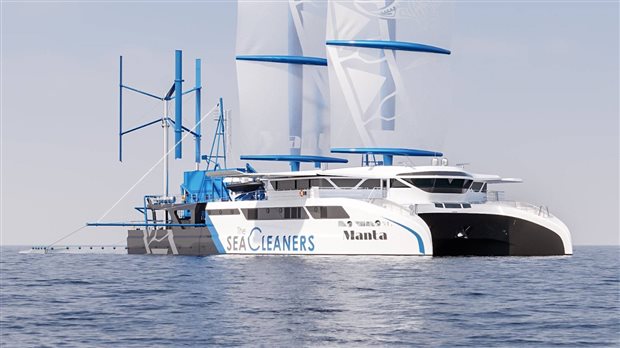The SeaCleaner’s Manta ship, which relies on renewable energy for power, is a ground-breaking solution for ocean cleanup. (Image Credit: Synthes3D for The SeaCleaners)
Manta, a cleanup vessel developed by the SeaCleaners, removes plastic waste from the sea on an industrial scale. Every hour, the ship takes in three tons of water, equivalent to 10,000 per year. Manta, a revolutionary solution for the environment, was envisioned by Yvan Bourgnon, who founded SeaCleaners in 2016. The Manta is expected to begin its first journey in 2025.
Back in 2015, Bourgnon dropped out of the Transat Jacques Vabre yacht races because plastic waste impacted his boat. As a result, he missed out on records due to his boat breaking twelve times from the debris. From sailing for over twenty years, Bourgnon realized there is a huge increase in plastic waste polluting the oceans.
SeaCleanup employs over 58 engineers and 17 external partners to design and construct the Manta. It features two wind turbines, 500 m2 of solar panels, and can reach 151 feet to collect plastic. A 22-person crew sorts out the debris, which is transported to onshore recycling units. This is then returned to the sea as organic matter. Plastic debris is sent to the Waste-to-Electricity Conversion unit, transforming the synthetic gas into energy that powers the Manta ship.
Bourgnon’s main goal involves the cleanup of coastal waters and river waterways. He says that southeast Asia rivers contain 60% of ocean plastic. For this purpose, the Manta ship’s focus involves targeting the Yangtze and Ganges rivers.
The Manta is significant for environmentalists, leading to new approaches that help to eliminate marine pollution. Currently, around 5.25 trillion micro and macro plastic debris float in the oceans. The Manta vessel is a vital solution to that problem.
Due to the huge pollution levels, individual efforts won’t be sufficient, so large-scale collaborations to clean up prove beneficial. Bourgnon hopes to build hundreds of Mantas, deploying them worldwide to help clean up the oceans.
Using renewable energy sources, such as wind and solar, to power these vessels paves the way for new transportation and technology opportunities in the future.
Have a story tip? Message me at: http://twitter.com/Cabe_Atwell


-

dubbie
-
Cancel
-
Vote Up
0
Vote Down
-
-
Sign in to reply
-
More
-
Cancel
Comment-

dubbie
-
Cancel
-
Vote Up
0
Vote Down
-
-
Sign in to reply
-
More
-
Cancel
Children